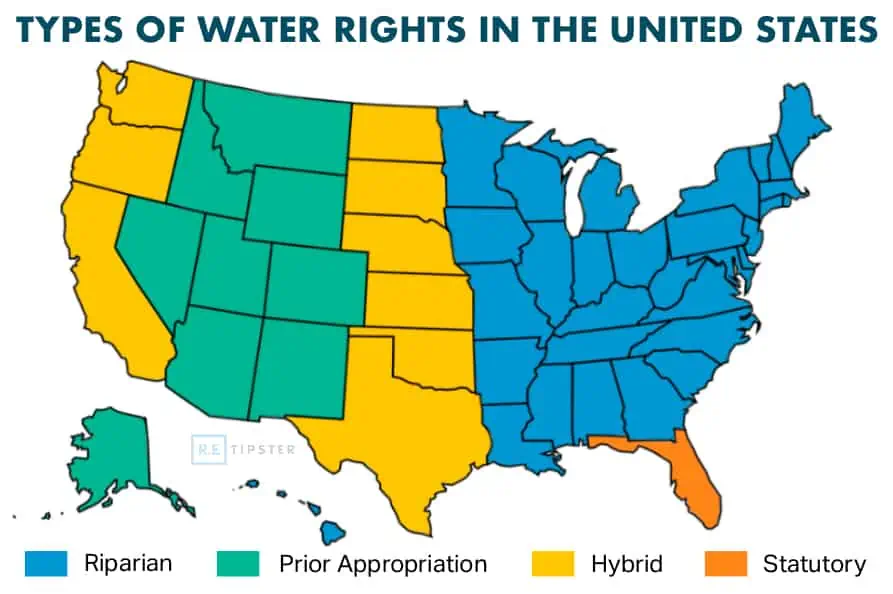What Are Water Rights?
REtipster does not provide legal advice. The information in this article can be impacted by many unique variables. Always consult with a qualified legal professional before taking action.
Shortcuts
- Water rights allow property owners to use and access water, typically within or adjacent to their property.
- The U.S. concept of water rights is regionally complex, with state-specific laws and regulations.
- There are two primary types of water rights: historical use (prior appropriation) and riparian rights.
- Water rights can apply to surface water (like rivers and lakes) and groundwater (like underground aquifers).
- Water rights significantly impact real estate development, agriculture, energy generation, water markets, and due diligence.
Understanding Water Rights
Water rights grant property owners to use and access water and its resources, typically within or adjacent to their property.
Due to the importance of water for survival, agriculture, and industrial purposes, establishing clear guidelines around its usage is the subject of legal and ethical concerns. For example, in the U.S., the concept of water rights is complex and regional, with laws and regulations often varying between states.
The recognition of water rights in terms of property ownership originated in English common law in the 1750s[1]. Over the decades, it has evolved through state statutes, court decisions, and administrative regulations.
Water Rights Allocation and Regulation
The allocation and regulation of water rights in the United States are primarily the responsibility of individual states, with the western and eastern states showing stark differences[2].
However, certain federal laws and agencies play a role in water rights, primarily regarding interstate water disputes, navigable waters, and water resources on federal lands. The U.S. Army Corps of Engineers[3], the Bureau of Reclamation, and the Environmental Protection Agency (EPA) are among the federal agencies involved in water rights management.
Additionally, federal laws, such as the Clean Water Act[4] and the Endangered Species Act, affect water usage and protection.
Types of Water Rights
There are two main types of water rights: historical use (prior appropriation) and riparian rights.
In many U.S. states, especially in the western part[5], historical use or prior appropriation (i.e., “first in time, first in right”) is the guiding principle. This means that the first person to use a quantity of water from a water source for a beneficial use has the right to continue to use that quantity of water for that purpose. This person is called the senior rights holder.
Under a historical use water right, later users can only claim the remaining water, provided they don’t infringe on senior users’ rights. For example, in periods of drought, senior rights holders receive their full allocation before junior rights holders.
Meanwhile, some states observe riparian rights instead. Under this system, popular in the eastern states, landowners have the right to use water from a water body that adjoins or crosses their property. Usage, however, must be reasonable relative to the needs of all other riparian owners.
Water rights are often subject to regulations set by local, state, or federal agencies, sometimes on top of these two primary types. These entities ensure that water usage remains sustainable, doesn’t endanger the ecosystem or other users’ rights, and applies to certain circumstances in the state or community. For example, California observes a “prescriptive water right,” which essentially grants water rights via adverse possession.
Water Rights Map
Below is a graphic showing which states use which type of water rights. Note that Hawaii uses a form of riparian rights[6] while Alaska’s is based on prior appropriation[7].
As the map shows, some states, such as Oklahoma and Texas, may also observe hybrid water rights that combine the riparian and prior appropriation[8]. In addition, Florida observes a unique water rights system that involves water use permits (WUPs) depending on the water consumption[9].
Groundwater vs. Surface Water Rights
Water rights apply to both surface water (such as from rivers and lakes) and groundwater (such as underground aquifers or similar water sources).
Understanding the difference between groundwater and surface water is crucial in understanding water rights.
Surface Water
Surface water is typically more visible and subject to more direct regulations and oversight. Under the U.S. public trust doctrine[10], certain bodies of water are held in trust for the public’s use and benefit, but access and usage may still be regulated.
Many jurisdictions make the distinction that property owners do not own the water itself but only have the right to use it[11][12]. Specifically, these rights allow owners to use water for various purposes (such as raising livestock or irrigation), divert it, or sell resources from the water.
Surface water is vital for drinking, irrigation, recreational activities, and maintaining ecosystems. Its quality can vary, making treatment necessary before use in certain applications.
Groundwater
Groundwater is water from an underground source, such as an aquifer or porous rock. While many jurisdictions have historically followed the “rule of capture,” modern regulations often limit unrestricted pumping to prevent harm to neighbors or aquifer depletion. It’s often used for drinking, irrigation, and industrial processes because it’s typically cleaner[13] than surface water.

Groundwater is usually cleaner than surface water, but it may contain harmful elements. A water treatment station typically removes these contaminants before they reach consumers.
Water rights are often subject to a “reasonable use” standard. While state agencies grant water use permits with sustainability in mind, those with water rights must still adhere to certain regulations to prevent overuse and adverse effects on others’ reasonable use.
Significance of Water Rights in Real Estate
Water rights have significant implications for real estate in the United States:
- Real estate development: Water rights are critical in real estate development, especially where water resources are scarce. The availability and reliability of water rights can impact property prices and the feasibility of development projects.
- Agriculture and irrigation: Water rights are critical for agricultural activities, particularly in areas that rely heavily on irrigation. Farmers and ranchers require stable water rights to keep their operations running and their land productive. Ready access to water resources has a direct bearing on the profitability of agricultural land.
- Energy generation: Water rights are also significant in the energy sector, such as for hydroelectric power plants. Water rights may also be relevant in other forms of energy generation, such as geothermal projects and nuclear power plants, that require billions of gallons of water for cooling[14].
- Water markets and trading: In regions where water scarcity is a concern, water rights can be bought, sold, or leased in water markets. Water rights trading allows individuals, organizations, and governments to transfer water rights from one user to another based on their needs and priorities. This mechanism allows for a more efficient allocation of water resources and can contribute to the economic value of water rights as tradable assets.
- Risk assessment and due diligence: Water rights are a critical component of due diligence for investors and financial institutions. When evaluating real estate or agricultural investments, it is essential to understand the status, validity, and reliability of the water rights associated with the property. Assessing water rights can help investors manage risks related to water availability, regulatory compliance, and potential conflicts.
Frequently Asked Questions: Water Rights
Can water rights be inherited?
Yes, water rights, like other property rights, can be passed down through inheritance[15].
However, the inheritor must adhere to the stipulations and regulations attached to those rights. It’s also essential to understand that inheriting the land doesn’t always mean inheriting the water rights; they might have been sold separately.
If in doubt, consult your local state board for the subtleties of water rights transfer.
How do water rights impact agricultural practices?
Agriculture consumes a significant portion of available freshwater; irrigation alone constitutes 42% of the nation’s freshwater consumption[16]. Thus, farmers rely heavily on water rights to irrigate crops.
The type and extent of these rights can dictate what crops are grown, as some require more water than others. Farmers might shift towards drought-resistant crops or employ water-saving techniques in areas with limited water rights or frequent droughts.
What happens when there’s a conflict between state and federal water rights?
In cases where state water rights clash with federal rights or regulations, it can lead to complex legal battles.
Typically, the Supremacy Clause of the Constitution[17] holds that federal laws have precedence over state laws. However, states can challenge this in court, especially if they believe the federal stance harms their residents or economy.
Sources
- Getzler, J. (2010, January 1.) History of Water Rights at Common Law. Oxford Studies in Modern Legal History. Oxford Academic. Retrieved from https://doi.org/10.1093/acprof:oso/9780199207602.001.0001
- Water Rights by State. (n.d.) AQUAOSO. Retrieved from https://aquaoso.com/water-rights/
- Are You Planning Work in a Waterway Or Wetland? (n.d.) US Army Corps of Engineers, New England District. Retrieved from https://www.nae.usace.army.mil/Portals/74/docs/regulatory/Forms/WorkInWaterway2014.pdf
- Summary of the Clean Water Act. (n.d.) United States Environmental Protection Agency. Retrieved from https://www.epa.gov/laws-regulations/summary-clean-water-act
- Water Appropriation Systems. (n.d.) University of North Dakota – Energy & Environmental Research Center. Retrieved from https://undeerc.org/water/decision-support/water-law/pdf/water-appr-systems.pdf
- Pilson, S. (2017, October 26.) Hawai`i water law overview. University of Montana. Retrieved from https://winapps.umt.edu/winapps/media2/wilderness/toolboxes/documents/water-rights/Hawaii%20Water%20Law%20Overview.pdf
- Water Resources Section. (n.d.) State of Alaska – Department of Natural Resources. Retrieved from https://dnr.alaska.gov/mlw/water/
- McDuffey, T. (n.d.) Underground Water Right Laws. LegalMatch. Retrieved from https://www.legalmatch.com/law-library/article/underground-water-right-lawyers.html
- Water Use Permit. (n.d.) Southwest Florida Water Management District. Retrieved from https://www.swfwmd.state.fl.us/business/epermitting/water-use-permit
- What Is the Public Trust? (n.d.) For Love of Water. Retrieved from https://forloveofwater.org/public-trust-solutions/what-is-public-trust/
- Understanding Water Rights. (n.d.) The Montana Department of Natural Resources and Conservation. Retrieved from https://dnrc.mt.gov/Water-Resources/Water-Rights/Understanding-Water-Rights/
- The Water Rights Process. (n.d.) The California Water Boards. Retrieved from https://www.waterboards.ca.gov/waterrights/board_info/water_rights_process.html
- Groundwater Vs Surface Water – What’s The Difference? (2022, June 15.) Atlas Scientific. Retrieved from https://atlas-scientific.com/blog/groundwater-vs-surface-water/
- Styles III, J.H. (2017, March 19.) Nuclear Power Plant Water Usage and Consumption. PH241 – Stanford University. Retrieved from http://large.stanford.edu/courses/2017/ph241/
- Water Rights Overview. (n.d.) Water Colorado. Retrieved from https://watercolorado.com/water-rights-overview/
- Irrigation & Water Use. (n.d.) U.S. Department of Agriculture. Retrieved from https://www.ers.usda.gov/topics/farm-practices-management/irrigation-water-use.aspx
- The Supremacy Clause. (2022, July 15.) FindLaw. Retrieved from https://constitution.findlaw.com/article6/annotation02.html












